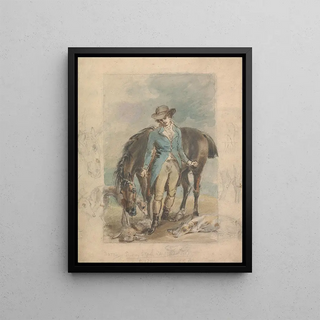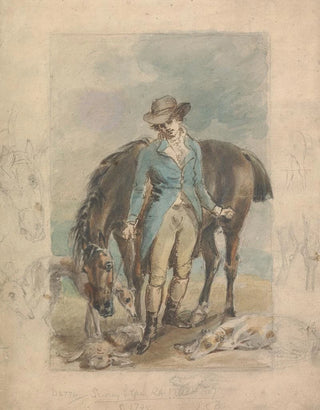Art print | A young man with a horse with studies of dogs and a dead hare - John Hoppner


View from behind

Frame (optional)
In the world of art, some works transcend mere representation to become witnesses of an era, visual narratives that connect us to past stories. "A young man with a horse with studies of dead dogs and a hare" by John Hoppner is one of those pieces that, through its composition and subject matter, evokes a universe rich in emotions and meanings. This painting, vibrant with inner life, immerses us in 18th-century English aristocracy, where nature and domesticity blend harmoniously. Through this work, Hoppner invites us to contemplate not only the beauty of the depicted subjects but also the depth of the relationships between man and his environment.
Style and uniqueness of the work
Hoppner's style is often characterized by an exceptional mastery of portraiture, but in this piece, he ventures beyond simple human representations to explore the dynamics between man, animal, and nature. The depiction of the young man, with a relaxed posture, reflects aristocratic ease, while the horse, noble and majestic, symbolizes power and freedom. The studies of dogs and the dead hare, placed in the background, add a dimension of realism and everyday life to the scene, evoking the hunting practices of the period. The color palette, subtly chosen, gives the overall atmosphere a sense of tranquility and melancholy, where every detail is carefully crafted, showcasing Hoppner's technical virtuosity.
The artist and his influence
John Hoppner, born in 1758, is often recognized as one of the most influential portraitists of his time. Trained under the guidance of Sir Joshua Reynolds, he developed a style that is uniquely his own, combining technical finesse with emotional sensitivity. Hoppner captured the essence of his models, endowing them with an almost mythical aura. His contribution to British art extends beyond his portraits to genre works where he explores a wider range of themes. Hoppner's impact on his contemporaries and future generations is profound.

Matte finish

View from behind

Frame (optional)
In the world of art, some works transcend mere representation to become witnesses of an era, visual narratives that connect us to past stories. "A young man with a horse with studies of dead dogs and a hare" by John Hoppner is one of those pieces that, through its composition and subject matter, evokes a universe rich in emotions and meanings. This painting, vibrant with inner life, immerses us in 18th-century English aristocracy, where nature and domesticity blend harmoniously. Through this work, Hoppner invites us to contemplate not only the beauty of the depicted subjects but also the depth of the relationships between man and his environment.
Style and uniqueness of the work
Hoppner's style is often characterized by an exceptional mastery of portraiture, but in this piece, he ventures beyond simple human representations to explore the dynamics between man, animal, and nature. The depiction of the young man, with a relaxed posture, reflects aristocratic ease, while the horse, noble and majestic, symbolizes power and freedom. The studies of dogs and the dead hare, placed in the background, add a dimension of realism and everyday life to the scene, evoking the hunting practices of the period. The color palette, subtly chosen, gives the overall atmosphere a sense of tranquility and melancholy, where every detail is carefully crafted, showcasing Hoppner's technical virtuosity.
The artist and his influence
John Hoppner, born in 1758, is often recognized as one of the most influential portraitists of his time. Trained under the guidance of Sir Joshua Reynolds, he developed a style that is uniquely his own, combining technical finesse with emotional sensitivity. Hoppner captured the essence of his models, endowing them with an almost mythical aura. His contribution to British art extends beyond his portraits to genre works where he explores a wider range of themes. Hoppner's impact on his contemporaries and future generations is profound.






